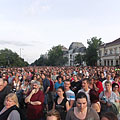(小さな画面のデバイス用に最適化)
Józsefváros, Keleti Railway Station - ブダペスト, ハンガリー
クリックした後:
写真をクリック
-
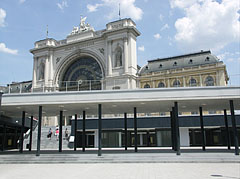
The Keleti Train Station with the half covered modern pedestrian subway system
撮影の日付:2014年06月10日2014
作成者:Robert Németh
カメラモデル:Konica Minolta Dimage A200
ブダペスト, ハンガリー
-

The new subway and the Keleti Railway Station
撮影の日付:2014年06月10日2014
作成者:Robert Németh
カメラモデル:Konica Minolta Dimage A200
ブダペスト, ハンガリー
-
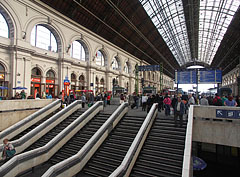
Wide stairs in the platform hall (or Great Hall)
撮影の日付:2013年09月20日2013
作成者:Robert Németh
カメラモデル:Konica Minolta Dimage A200
ブダペスト, ハンガリー
-
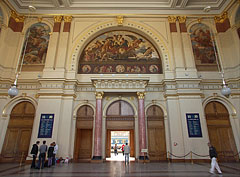
The decorated waiting hall of the Keleti Railway Station (the so-called Lotz Hall)
撮影の日付:2013年09月20日2013
作成者:Robert Németh
カメラモデル:Konica Minolta Dimage A200
ブダペスト, ハンガリー
-

The main entrance of the Keleti Railway Station
撮影の日付:2014年06月10日2014
作成者:Robert Németh
カメラモデル:Konica Minolta Dimage A200
ブダペスト, ハンガリー
-

Parking lot and the north side of the Keleti Train Terminal building
撮影の日付:2014年06月10日2014
作成者:Robert Németh
カメラモデル:Konica Minolta Dimage A200
ブダペスト, ハンガリー
-
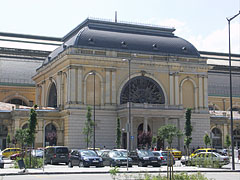
The north entrance of the Keleti Train Station, the departure lounge and ornate waiting hall from outside
撮影の日付:2014年06月10日2014
作成者:Robert Németh
カメラモデル:Konica Minolta Dimage A200
ブダペスト, ハンガリー
-
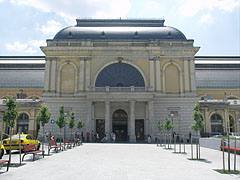
The ornate departure hall of the Keleti Railroad Station from outside
撮影の日付:2014年06月10日2014
作成者:Robert Németh
カメラモデル:Konica Minolta Dimage A200
ブダペスト, ハンガリー
-
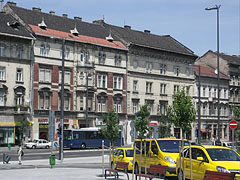
Four-story residental buildings and yellow taxies in the north side of the Baross Square
撮影の日付:2014年06月10日2014
作成者:Robert Németh
カメラモデル:Konica Minolta Dimage A200
ブダペスト, ハンガリー
-
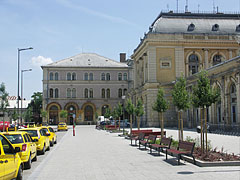
Taxi stand and small park in the north part of the Baross Square, near the Keleti Railway Station
撮影の日付:2014年06月10日2014
作成者:Robert Németh
カメラモデル:Konica Minolta Dimage A200
ブダペスト, ハンガリー
-
The main post office at the Keleti Train Terminal
撮影の日付:2014年06月10日2014
作成者:Robert Németh
カメラモデル:Konica Minolta Dimage A200
ブダペスト, ハンガリー
The main post office at the Keleti Train Terminal - ブダペスト, ハンガリー -
The nort side of the Keleti Train Terminal
撮影の日付:2014年06月10日2014
作成者:Robert Németh
カメラモデル:Konica Minolta Dimage A200
ブダペスト, ハンガリー
The nort side of the Keleti Train Terminal - ブダペスト, ハンガリー -
The "Agriculture" wall painting in the Lotz Hall
Created by Károly Lotz Hungarian painter in 1884.
撮影の日付:2014年06月10日2014
作成者:Robert Németh
カメラモデル:Konica Minolta Dimage A200
ブダペスト, ハンガリー
The "Agriculture" wall painting in the Lotz Hall - ブダペスト, ハンガリー -
The Lotz Hall of the railway station
撮影の日付:2014年06月10日2014
作成者:Robert Németh
カメラモデル:Konica Minolta Dimage A200
ブダペスト, ハンガリー
The Lotz Hall of the railway station - ブダペスト, ハンガリー -
Lotz Hall in the train station
撮影の日付:2014年06月10日2014
作成者:Robert Németh
カメラモデル:Konica Minolta Dimage A200
ブダペスト, ハンガリー
Lotz Hall in the train station - ブダペスト, ハンガリー -
The Lotz Hall is the former departure hall
The titles of the murals: "Bridge construction" and "Post", artworks of Károly Lotz from 1884.
撮影の日付:2014年06月10日2014
作成者:Robert Németh
カメラモデル:Konica Minolta Dimage A200
ブダペスト, ハンガリー
The Lotz Hall is the former departure hall - ブダペスト, ハンガリー -
The "Trade" allegorical wall painting in the Lotz Hall
Created by Károly Lotz Hungarian painter in 1884.
撮影の日付:2014年06月10日2014
作成者:Robert Németh
カメラモデル:Konica Minolta Dimage A200
ブダペスト, ハンガリー
The "Trade" allegorical wall painting in the Lotz Hall - ブダペスト, ハンガリー -
The ornate Lotz Hall
撮影の日付:2014年06月10日2014
作成者:Robert Németh
カメラモデル:Konica Minolta Dimage A200
ブダペスト, ハンガリー
The ornate Lotz Hall - ブダペスト, ハンガリー -
The interior of the main hall, also known as train shed or overall roof in the Keleti Railway Station
The dimensions of the hall: 188 meters in length, 44 meters in width and 31.5 meters in height.
撮影の日付:2014年06月10日2014
作成者:Robert Németh
カメラモデル:Konica Minolta Dimage A200
ブダペスト, ハンガリー
The interior of the main hall, also known as train shed or overall roof in the Keleti Railway Station - ブダペスト, ハンガリー -
The view of the square from the main entrance of the Keleti Train Terminal
撮影の日付:2014年06月10日2014
作成者:Robert Németh
カメラモデル:Konica Minolta Dimage A200
ブダペスト, ハンガリー
The view of the square from the main entrance of the Keleti Train Terminal - ブダペスト, ハンガリー -
Stairs at the main entrance of the Keleti Railway station
撮影の日付:2014年06月10日2014
作成者:Robert Németh
カメラモデル:Konica Minolta Dimage A200
ブダペスト, ハンガリー
Stairs at the main entrance of the Keleti Railway station - ブダペスト, ハンガリー -
A renovated old residental building on the Baross Square, viewed from the stairs of the Keleti Train Station
撮影の日付:2014年06月10日2014
作成者:Robert Németh
カメラモデル:Konica Minolta Dimage A200
ブダペスト, ハンガリー
A renovated old residental building on the Baross Square, viewed from the stairs of the Keleti Train Station - ブダペスト, ハンガリー -
The main hall of the Keleti Railway Station
撮影の日付:2014年06月10日2014
作成者:Robert Németh
カメラモデル:Konica Minolta Dimage A200
ブダペスト, ハンガリー
The main hall of the Keleti Railway Station - ブダペスト, ハンガリー -
Baross Square
撮影の日付:2014年06月10日2014
作成者:Robert Németh
カメラモデル:Konica Minolta Dimage A200
ブダペスト, ハンガリー
Baross Square - ブダペスト, ハンガリー -
The new pedestrian subway system in Baross Square
撮影の日付:2014年06月10日2014
作成者:Robert Németh
カメラモデル:Konica Minolta Dimage A200
ブダペスト, ハンガリー
The new pedestrian subway system in Baross Square - ブダペスト, ハンガリー -
The secession style 4-star Golden Park Hotel from the subway
The hotel was built in 1918, in World War II it was seriously damaged, then it was reconstructed in 1959.
撮影の日付:2014年06月10日2014
作成者:Robert Németh
カメラモデル:Konica Minolta Dimage A200
ブダペスト, ハンガリー
The secession style 4-star Golden Park Hotel from the subway - ブダペスト, ハンガリー -
Stone sculpture group on the top of the Keletio Railway Station
撮影の日付:2014年06月10日2014
作成者:Robert Németh
カメラモデル:Konica Minolta Dimage A200
ブダペスト, ハンガリー
Stone sculpture group on the top of the Keletio Railway Station - ブダペスト, ハンガリー -
Statue of James Watt (1736-1819) Scottish engineer, inventor of the steam-engine on the facade of the Keleti Railway Station
The statue is standing in the right side big niche, created by Alajos Stróbl in 1884.
撮影の日付:2014年06月10日2014
作成者:Robert Németh
カメラモデル:Konica Minolta Dimage A200
ブダペスト, ハンガリー
Statue of James Watt (1736-1819) Scottish engineer, inventor of the steam-engine on the facade of the Keleti Railway Station - ブダペスト, ハンガリー -
Looking to the Keleti Railway Terminal building from the wide stairs of the pedestrian subway
撮影の日付:2014年06月10日2014
作成者:Robert Németh
カメラモデル:Konica Minolta Dimage A200
ブダペスト, ハンガリー
Looking to the Keleti Railway Terminal building from the wide stairs of the pedestrian subway - ブダペスト, ハンガリー -
Pedestrian underpass (or subway)
撮影の日付:2014年06月10日2014
作成者:Robert Németh
カメラモデル:Konica Minolta Dimage A200
ブダペスト, ハンガリー
Pedestrian underpass (or subway) - ブダペスト, ハンガリー -
Two residental buildings on the Baross Square (one is a hotel, the other is a fastfood restaurant)
撮影の日付:2014年06月10日2014
作成者:Robert Németh
カメラモデル:Konica Minolta Dimage A200
ブダペスト, ハンガリー
Two residental buildings on the Baross Square (one is a hotel, the other is a fastfood restaurant) - ブダペスト, ハンガリー -
Half-open pedestrian subway system in the middle of the Baross Square
撮影の日付:2014年06月10日2014
作成者:Robert Németh
カメラモデル:Konica Minolta Dimage A200
ブダペスト, ハンガリー
Half-open pedestrian subway system in the middle of the Baross Square - ブダペスト, ハンガリー -
Keleti Railway Terminal (Hungarian word "keleti" means "eastern")
撮影の日付:2014年06月10日2014
作成者:Robert Németh
カメラモデル:Konica Minolta Dimage A200
ブダペスト, ハンガリー
Keleti Railway Terminal (Hungarian word "keleti" means "eastern") - ブダペスト, ハンガリー -
Renewed pedestrian subway under the square
撮影の日付:2014年06月10日2014
作成者:Robert Németh
カメラモデル:Konica Minolta Dimage A200
ブダペスト, ハンガリー
Renewed pedestrian subway under the square - ブダペスト, ハンガリー -
Pedestrial subway system in Baross Square
撮影の日付:2014年06月10日2014
作成者:Robert Németh
カメラモデル:Konica Minolta Dimage A200
ブダペスト, ハンガリー
Pedestrial subway system in Baross Square - ブダペスト, ハンガリー -
The main facade of the eclectic style impressive Keleti Train Station
It was built in 1884, the building was designed by Gyula Rochlitz and the main hall by János Feketeházy.
撮影の日付:2014年06月10日2014
作成者:Robert Németh
カメラモデル:Konica Minolta Dimage A200
ブダペスト, ハンガリー
The main facade of the eclectic style impressive Keleti Train Station - ブダペスト, ハンガリー -
Statue of George Stephenson (1781-1848) English engineer on the main wall of the Keleti Railway Station
The statue is standing in the left side large sculpture niche, created by Ferenc Vasadi Ferenc in 1884.
撮影の日付:2014年06月10日2014
作成者:Robert Németh
カメラモデル:Konica Minolta Dimage A200
ブダペスト, ハンガリー
Statue of George Stephenson (1781-1848) English engineer on the main wall of the Keleti Railway Station - ブダペスト, ハンガリー -
The main hall of the Keleti Train Terminal from outside, on the facade there is the characteristic large semicircular glass wall
撮影の日付:2014年06月10日2014
作成者:Robert Németh
カメラモデル:Konica Minolta Dimage A200
ブダペスト, ハンガリー
The main hall of the Keleti Train Terminal from outside, on the facade there is the characteristic large semicircular glass wall - ブダペスト, ハンガリー -
The outer central clock of the Keleti Railway Terminal
撮影の日付:2014年06月10日2014
作成者:Robert Németh
カメラモデル:Konica Minolta Dimage A200
ブダペスト, ハンガリー
The outer central clock of the Keleti Railway Terminal - ブダペスト, ハンガリー -
Details of the Baross Square at the Keleti Train Station
撮影の日付:2014年06月10日2014
作成者:Robert Németh
カメラモデル:Konica Minolta Dimage A200
ブダペスト, ハンガリー
Details of the Baross Square at the Keleti Train Station - ブダペスト, ハンガリー -
The main building of the Keleti Railway Station
撮影の日付:2014年06月10日2014
作成者:Robert Németh
カメラモデル:Konica Minolta Dimage A200
ブダペスト, ハンガリー
The main building of the Keleti Railway Station - ブダペスト, ハンガリー -
Keleti Railway Station (or Keleti Railroad Station, Keleti Train Terminal, in Hungarian: "Keleti pályaudvar")
撮影の日付:2014年06月10日2014
作成者:Robert Németh
カメラモデル:Konica Minolta Dimage A200
ブダペスト, ハンガリー
Keleti Railway Station (or Keleti Railroad Station, Keleti Train Terminal, in Hungarian: "Keleti pályaudvar") - ブダペスト, ハンガリー -
Spacious half covered renovated pedestrian subway system
撮影の日付:2014年06月10日2014
作成者:Robert Németh
カメラモデル:Konica Minolta Dimage A200
ブダペスト, ハンガリー
Spacious half covered renovated pedestrian subway system - ブダペスト, ハンガリー -
The Keleti Reilway Station building viewed from pedestrian underpass stairs in the middle of the square, that is recessed under the street level
撮影の日付:2014年06月10日2014
作成者:Robert Németh
カメラモデル:Konica Minolta Dimage A200
ブダペスト, ハンガリー
The Keleti Reilway Station building viewed from pedestrian underpass stairs in the middle of the square, that is recessed under the street level - ブダペスト, ハンガリー -
One of the stairs of the pedestrian subway, as well as the Keleti Railway Station
撮影の日付:2014年06月10日2014
作成者:Robert Németh
カメラモデル:Konica Minolta Dimage A200
ブダペスト, ハンガリー
One of the stairs of the pedestrian subway, as well as the Keleti Railway Station - ブダペスト, ハンガリー -
The modern, spacious and sunny subway in front of the Keleti Train Station is built in place of an older pedestrian underpass, which was rundown after the many decades
But of course when it was constructed in 1968, the former pedestrian subway system was also quite advanced.
撮影の日付:2014年06月10日2014
作成者:Robert Németh
カメラモデル:Konica Minolta Dimage A200
ブダペスト, ハンガリー
The modern, spacious and sunny subway in front of the Keleti Train Station is built in place of an older pedestrian underpass, which was rundown after the many decades - ブダペスト, ハンガリー -
The renovated and modern subway system in the middle of the square in front of the Keleti Railway Station
Or in different point of view, the square itself is recessed under the street floor.
撮影の日付:2014年06月10日2014
作成者:Robert Németh
カメラモデル:Konica Minolta Dimage A200
ブダペスト, ハンガリー
The renovated and modern subway system in the middle of the square in front of the Keleti Railway Station - ブダペスト, ハンガリー -
Looking to the main facade of the Keleti Train Terminal from the pedestrian subway
撮影の日付:2014年06月10日2014
作成者:Robert Németh
カメラモデル:Konica Minolta Dimage A200
ブダペスト, ハンガリー
Looking to the main facade of the Keleti Train Terminal from the pedestrian subway - ブダペスト, ハンガリー -
Krokodil Corso shoe store downstairs in the seven-story residental building
撮影の日付:2014年06月10日2014
作成者:Robert Németh
カメラモデル:Konica Minolta Dimage A200
ブダペスト, ハンガリー
Krokodil Corso shoe store downstairs in the seven-story residental building - ブダペスト, ハンガリー -
An entrance of the pedestrian subway with the Gábor Baross statue beside it, and the Keleti Train Station in the background
撮影の日付:2014年06月10日2014
作成者:Robert Németh
カメラモデル:Konica Minolta Dimage A200
ブダペスト, ハンガリー
An entrance of the pedestrian subway with the Gábor Baross statue beside it, and the Keleti Train Station in the background - ブダペスト, ハンガリー -
Gábor Baross sculpture group
Created by Antal Szécsi in 1898
撮影の日付:2014年06月10日2014
作成者:Robert Németh
カメラモデル:Konica Minolta Dimage A200
ブダペスト, ハンガリー
Gábor Baross sculpture group - ブダペスト, ハンガリー -
Bronze statur group of Gábor Baross (1848-1892) famous Hungarian politician, in his time often called the "iron minister"
撮影の日付:2014年06月10日2014
作成者:Robert Németh
カメラモデル:Konica Minolta Dimage A200
ブダペスト, ハンガリー
Bronze statur group of Gábor Baross (1848-1892) famous Hungarian politician, in his time often called the "iron minister" - ブダペスト, ハンガリー -
The renovated Baross Square with the overpass (or in other word flyover)
撮影の日付:2014年06月10日2014
作成者:Robert Németh
カメラモデル:Konica Minolta Dimage A200
ブダペスト, ハンガリー
The renovated Baross Square with the overpass (or in other word flyover) - ブダペスト, ハンガリー -
The Keleti Train Station and the Gábor Baross statue, the latter stands now almost at its original position again since the renovation of the square in 2013
撮影の日付:2014年06月10日2014
作成者:Robert Németh
カメラモデル:Konica Minolta Dimage A200
ブダペスト, ハンガリー
The Keleti Train Station and the Gábor Baross statue, the latter stands now almost at its original position again since the renovation of the square in 2013 - ブダペスト, ハンガリー -
Bronze laurel wreath on the Gábor Baross statue group, above it there is the allegorical male figure of the industry
撮影の日付:2014年06月10日2014
作成者:Robert Németh
カメラモデル:Konica Minolta Dimage A200
ブダペスト, ハンガリー
Bronze laurel wreath on the Gábor Baross statue group, above it there is the allegorical male figure of the industry - ブダペスト, ハンガリー -
Bronze male figure, the allegorical character of the transport
撮影の日付:2014年06月10日2014
作成者:Robert Németh
カメラモデル:Konica Minolta Dimage A200
ブダペスト, ハンガリー
Bronze male figure, the allegorical character of the transport - ブダペスト, ハンガリー -
Lying male figure and a steam locomotive on the Gábor Baross sculpture group (this symbolizes the connection between the statesman and the railway)
撮影の日付:2014年06月10日2014
作成者:Robert Németh
カメラモデル:Konica Minolta Dimage A200
ブダペスト, ハンガリー
Lying male figure and a steam locomotive on the Gábor Baross sculpture group (this symbolizes the connection between the statesman and the railway) - ブダペスト, ハンガリー -
Four-storey old apartment house on the Erzsébetváros side of the square
撮影の日付:2014年06月10日2014
作成者:Robert Németh
カメラモデル:Konica Minolta Dimage A200
ブダペスト, ハンガリー
Four-storey old apartment house on the Erzsébetváros side of the square - ブダペスト, ハンガリー -
The little bit rusty manhole cover of the Sewage Works Company
撮影の日付:2014年06月10日2014
作成者:Robert Németh
カメラモデル:Konica Minolta Dimage A200
ブダペスト, ハンガリー
The little bit rusty manhole cover of the Sewage Works Company - ブダペスト, ハンガリー -
Budapest Keleti Railway Station (in Hungarian: "Keleti pályaudvar")
撮影の日付:2014年06月10日2014
作成者:Robert Németh
カメラモデル:Konica Minolta Dimage A200
ブダペスト, ハンガリー
Budapest Keleti Railway Station (in Hungarian: "Keleti pályaudvar") - ブダペスト, ハンガリー -
The Keleti Railway Station and the new pedestrian subway
撮影の日付:2014年06月10日2014
作成者:Robert Németh
カメラモデル:Konica Minolta Dimage A200
ブダペスト, ハンガリー
The Keleti Railway Station and the new pedestrian subway - ブダペスト, ハンガリー -
The 3-star Hotel Baross is in an Art Nouveau style apartment house
Built in 1907, architect: Albert Kőrössy
撮影の日付:2014年06月10日2014
作成者:Robert Németh
カメラモデル:Konica Minolta Dimage A200
ブダペスト, ハンガリー
The 3-star Hotel Baross is in an Art Nouveau style apartment house - ブダペスト, ハンガリー -
Bus stop on the north side of the square, and the Keleti Train Station
撮影の日付:2014年06月10日2014
作成者:Robert Németh
カメラモデル:Konica Minolta Dimage A200
ブダペスト, ハンガリー
Bus stop on the north side of the square, and the Keleti Train Station - ブダペスト, ハンガリー -
The stop of the city bus line 112 at the Keleti Railway Terminal
撮影の日付:2014年06月10日2014
作成者:Robert Németh
カメラモデル:Konica Minolta Dimage A200
ブダペスト, ハンガリー
The stop of the city bus line 112 at the Keleti Railway Terminal - ブダペスト, ハンガリー -
Golden Park Hotel
撮影の日付:2014年06月10日2014
作成者:Robert Németh
カメラモデル:Konica Minolta Dimage A200
ブダペスト, ハンガリー
Golden Park Hotel - ブダペスト, ハンガリー -
Baross Square with the Golden Park Hotel in the background
撮影の日付:2014年06月10日2014
作成者:Robert Németh
カメラモデル:Konica Minolta Dimage A200
ブダペスト, ハンガリー
Baross Square with the Golden Park Hotel in the background - ブダペスト, ハンガリー -
Baross Square underpass
撮影の日付:2014年06月10日2014
作成者:Robert Németh
カメラモデル:Konica Minolta Dimage A200
ブダペスト, ハンガリー
Baross Square underpass - ブダペスト, ハンガリー -
Keleti Railway Terminal
撮影の日付:2014年06月10日2014
作成者:Robert Németh
カメラモデル:Konica Minolta Dimage A200
ブダペスト, ハンガリー
Keleti Railway Terminal - ブダペスト, ハンガリー -
The main facade of the Keleti Railway Station
撮影の日付:2014年06月10日2014
作成者:Robert Németh
カメラモデル:Konica Minolta Dimage A200
ブダペスト, ハンガリー
The main facade of the Keleti Railway Station - ブダペスト, ハンガリー -
Four allegorical figures in the statue on the top of the Keleti Railway Station, above the main entrance
撮影の日付:2014年06月10日2014
作成者:Robert Németh
カメラモデル:Konica Minolta Dimage A200
ブダペスト, ハンガリー
Four allegorical figures in the statue on the top of the Keleti Railway Station, above the main entrance - ブダペスト, ハンガリー -
The central clock of the Keleti Train Station on the outer wall
撮影の日付:2014年06月10日2014
作成者:Robert Németh
カメラモデル:Konica Minolta Dimage A200
ブダペスト, ハンガリー
The central clock of the Keleti Train Station on the outer wall - ブダペスト, ハンガリー -
The top of the Keleti Train Terminal building with the characteristic sculpture called "The allegory of the transport"
Created by Gyula Bezerédi Gyula in 1884
撮影の日付:2014年06月10日2014
作成者:Robert Németh
カメラモデル:Konica Minolta Dimage A200
ブダペスト, ハンガリー
The top of the Keleti Train Terminal building with the characteristic sculpture called "The allegory of the transport" - ブダペスト, ハンガリー -
The allegorical statue on the top of the facade of the Keleti Railway Station
撮影の日付:2014年06月10日2014
作成者:Robert Németh
カメラモデル:Konica Minolta Dimage A200
ブダペスト, ハンガリー
The allegorical statue on the top of the facade of the Keleti Railway Station - ブダペスト, ハンガリー -
The entrance of the Keleti Train Station on the main wall
撮影の日付:2014年06月10日2014
作成者:Robert Németh
カメラモデル:Konica Minolta Dimage A200
ブダペスト, ハンガリー
The entrance of the Keleti Train Station on the main wall - ブダペスト, ハンガリー -
The renovated underpass of the Baross Square
撮影の日付:2014年06月10日2014
作成者:Robert Németh
カメラモデル:Konica Minolta Dimage A200
ブダペスト, ハンガリー
The renovated underpass of the Baross Square - ブダペスト, ハンガリー -
The renovated pedestrian subway in the Baross Square
撮影の日付:2014年06月10日2014
作成者:Robert Németh
カメラモデル:Konica Minolta Dimage A200
ブダペスト, ハンガリー
The renovated pedestrian subway in the Baross Square - ブダペスト, ハンガリー -
M4 (green) metro line, the way down with the elevators to the "Keleti pályaudvar" station
撮影の日付:2014年06月10日2014
作成者:Robert Németh
カメラモデル:Konica Minolta Dimage A200
ブダペスト, ハンガリー
M4 (green) metro line, the way down with the elevators to the "Keleti pályaudvar" station - ブダペスト, ハンガリー -
M4 (green) metro line, "Keleti pályaudvar" (Keleti train Terminal) station, way down to the platforms
撮影の日付:2014年06月10日2014
作成者:Robert Németh
カメラモデル:Konica Minolta Dimage A200
ブダペスト, ハンガリー
M4 (green) metro line, "Keleti pályaudvar" (Keleti train Terminal) station, way down to the platforms - ブダペスト, ハンガリー -
Pedestrian underpass in the Baross Square
撮影の日付:2014年06月10日2014
作成者:Robert Németh
カメラモデル:Konica Minolta Dimage A200
ブダペスト, ハンガリー
Pedestrian underpass in the Baross Square - ブダペスト, ハンガリー -
M4 (green) metro line, the way down to the "Keleti pályaudvar" (Keleti Railway Terminal) station
撮影の日付:2014年06月10日2014
作成者:Robert Németh
カメラモデル:Konica Minolta Dimage A200
ブダペスト, ハンガリー
M4 (green) metro line, the way down to the "Keleti pályaudvar" (Keleti Railway Terminal) station - ブダペスト, ハンガリー -
Pedestrian underpass at the Baross Square
撮影の日付:2014年06月10日2014
作成者:Robert Németh
カメラモデル:Konica Minolta Dimage A200
ブダペスト, ハンガリー
Pedestrian underpass at the Baross Square - ブダペスト, ハンガリー -
The Great Hall (central platform hall or track hall) of the Budapest Keleti Rrailway Station
撮影の日付:2013年09月20日2013
作成者:Robert Németh
カメラモデル:Konica Minolta Dimage A200
ブダペスト, ハンガリー
The Great Hall (central platform hall or track hall) of the Budapest Keleti Rrailway Station - ブダペスト, ハンガリー -
The Lotz Hall (reception hall or vestibule) of the Keleti Train Terminal
撮影の日付:2013年09月20日2013
作成者:Robert Németh
カメラモデル:Konica Minolta Dimage A200
ブダペスト, ハンガリー
The Lotz Hall (reception hall or vestibule) of the Keleti Train Terminal - ブダペスト, ハンガリー -
"Mining", a fresco in the ceremonial hall (the Lotz Hall)
撮影の日付:2013年09月20日2013
作成者:Robert Németh
カメラモデル:Konica Minolta Dimage A200
ブダペスト, ハンガリー
"Mining", a fresco in the ceremonial hall (the Lotz Hall) - ブダペスト, ハンガリー -
Doorway from the decorative reception hall (Lotz Hall) to the tracks and the trains
撮影の日付:2013年09月20日2013
作成者:Robert Németh
カメラモデル:Konica Minolta Dimage A200
ブダペスト, ハンガリー
Doorway from the decorative reception hall (Lotz Hall) to the tracks and the trains - ブダペスト, ハンガリー -
Decorative lamp in the Lotz Hall
撮影の日付:2013年09月20日2013
作成者:Robert Németh
カメラモデル:Konica Minolta Dimage A200
ブダペスト, ハンガリー
Decorative lamp in the Lotz Hall - ブダペスト, ハンガリー -
The central mural (wall painting) of the Lotz Hall: "Railway and Traffic"
Painted by Mór Than in 1884
撮影の日付:2013年09月20日2013
作成者:Robert Németh
カメラモデル:Konica Minolta Dimage A200
ブダペスト, ハンガリー
The central mural (wall painting) of the Lotz Hall: "Railway and Traffic" - ブダペスト, ハンガリー -
Wall painting by Mór Than in the Lotz Hall: "Railway and Traffic" (1884)
撮影の日付:2013年09月20日2013
作成者:Robert Németh
カメラモデル:Konica Minolta Dimage A200
ブダペスト, ハンガリー
Wall painting by Mór Than in the Lotz Hall: "Railway and Traffic" (1884) - ブダペスト, ハンガリー -
The corridor leads to the international ticket offices
撮影の日付:2013年09月20日2013
作成者:Robert Németh
カメラモデル:Konica Minolta Dimage A200
ブダペスト, ハンガリー
The corridor leads to the international ticket offices - ブダペスト, ハンガリー -
The Lotz Hall of the Keleti Railway Station, with wall paintings by Mór Than
撮影の日付:2013年09月20日2013
作成者:Robert Németh
カメラモデル:Konica Minolta Dimage A200
ブダペスト, ハンガリー
The Lotz Hall of the Keleti Railway Station, with wall paintings by Mór Than - ブダペスト, ハンガリー -
Passage from the ceremonial hall to the platforms
撮影の日付:2013年09月20日2013
作成者:Robert Németh
カメラモデル:Konica Minolta Dimage A200
ブダペスト, ハンガリー
Passage from the ceremonial hall to the platforms - ブダペスト, ハンガリー -
The ceremonial hall of the Keleti Train Station (the so-called Lotz Hall)
撮影の日付:2013年09月20日2013
作成者:Robert Németh
カメラモデル:Konica Minolta Dimage A200
ブダペスト, ハンガリー
The ceremonial hall of the Keleti Train Station (the so-called Lotz Hall) - ブダペスト, ハンガリー -
Murals by Mór Than and Károly Lotz Hungarian painters in the ceremonial hall (namely the Lotz Hall)
撮影の日付:2013年09月20日2013
作成者:Robert Németh
カメラモデル:Konica Minolta Dimage A200
ブダペスト, ハンガリー
Murals by Mór Than and Károly Lotz Hungarian painters in the ceremonial hall (namely the Lotz Hall) - ブダペスト, ハンガリー -
The corridor to the international ticket offices
撮影の日付:2013年09月20日2013
作成者:Robert Németh
カメラモデル:Konica Minolta Dimage A200
ブダペスト, ハンガリー
The corridor to the international ticket offices - ブダペスト, ハンガリー -
One of the side halls from inside, viewed from the central hall
撮影の日付:2013年09月20日2013
作成者:Robert Németh
カメラモデル:Konica Minolta Dimage A200
ブダペスト, ハンガリー
One of the side halls from inside, viewed from the central hall - ブダペスト, ハンガリー -
The main hall of the Keleti Train Station (in other words central hall or platform hall)
撮影の日付:2013年09月20日2013
作成者:Robert Németh
カメラモデル:Konica Minolta Dimage A200
ブダペスト, ハンガリー
The main hall of the Keleti Train Station (in other words central hall or platform hall) - ブダペスト, ハンガリー -
The central hall of the Keleti Railway Station with trains
Initially there were 5 tracks and platforms in the main hall, but in the 1980s it was converted to the current 4-platformed version. Of course outside of the central hall there are more other platforms and tracks.
撮影の日付:2013年09月20日2013
作成者:Robert Németh
カメラモデル:Konica Minolta Dimage A200
ブダペスト, ハンガリー
The central hall of the Keleti Railway Station with trains - ブダペスト, ハンガリー -
The central hall of the Keleti Railway Terminal, the passenger information board close to the main entrance
撮影の日付:2013年09月20日2013
作成者:Robert Németh
カメラモデル:Konica Minolta Dimage A200
ブダペスト, ハンガリー
The central hall of the Keleti Railway Terminal, the passenger information board close to the main entrance - ブダペスト, ハンガリー -
Wide stairs lead from the platform hall down to the underpass
撮影の日付:2013年09月20日2013
作成者:Robert Németh
カメラモデル:Konica Minolta Dimage A200
ブダペスト, ハンガリー
Wide stairs lead from the platform hall down to the underpass - ブダペスト, ハンガリー -
Wide stairs lead up to the platforms from the underpass
撮影の日付:2013年09月20日2013
作成者:Robert Németh
カメラモデル:Konica Minolta Dimage A200
ブダペスト, ハンガリー
Wide stairs lead up to the platforms from the underpass - ブダペスト, ハンガリー -
The front wall of the Keleti Railway Terminal, viewed from its main entrance
撮影の日付:2013年09月20日2013
作成者:Robert Németh
カメラモデル:Konica Minolta Dimage A200
ブダペスト, ハンガリー
The front wall of the Keleti Railway Terminal, viewed from its main entrance - ブダペスト, ハンガリー -
The facade of the Keleti Railway Station, viewed from the main entrance
撮影の日付:2013年09月20日2013
作成者:Robert Németh
カメラモデル:Konica Minolta Dimage A200
ブダペスト, ハンガリー
The facade of the Keleti Railway Station, viewed from the main entrance - ブダペスト, ハンガリー -
"The Miner", one of the four recently recreated statues on the main facade
撮影の日付:2013年09月20日2013
作成者:Robert Németh
カメラモデル:Konica Minolta Dimage A200
ブダペスト, ハンガリー
"The Miner", one of the four recently recreated statues on the main facade - ブダペスト, ハンガリー -
The outer clock of the Keleti Railwaystation
撮影の日付:2013年09月20日2013
作成者:Robert Németh
カメラモデル:Konica Minolta Dimage A200
ブダペスト, ハンガリー
The outer clock of the Keleti Railwaystation - ブダペスト, ハンガリー -
Passers-by in front of the train terminal
撮影の日付:2013年09月20日2013
作成者:Robert Németh
カメラモデル:Konica Minolta Dimage A200
ブダペスト, ハンガリー
Passers-by in front of the train terminal - ブダペスト, ハンガリー -
In front of the Keleti Railway Terminal the station of the Metro Line 4 is being built
撮影の日付:2013年09月20日2013
作成者:Robert Németh
カメラモデル:Konica Minolta Dimage A200
ブダペスト, ハンガリー
In front of the Keleti Railway Terminal the station of the Metro Line 4 is being built - ブダペスト, ハンガリー -
Group of statues on the frontage of the train terminal
撮影の日付:2013年09月20日2013
作成者:Robert Németh
カメラモデル:Konica Minolta Dimage A200
ブダペスト, ハンガリー
Group of statues on the frontage of the train terminal - ブダペスト, ハンガリー -
The frontage of the Keleti Railway Terminal
撮影の日付:2013年09月20日2013
作成者:Robert Németh
カメラモデル:Konica Minolta Dimage A200
ブダペスト, ハンガリー
The frontage of the Keleti Railway Terminal - ブダペスト, ハンガリー -
The front wall of the Keleti Railway Terminal
撮影の日付:2013年09月20日2013
作成者:Robert Németh
カメラモデル:Konica Minolta Dimage A200
ブダペスト, ハンガリー
The front wall of the Keleti Railway Terminal - ブダペスト, ハンガリー -
The Keleti Railway Terminal is the largest train station in Budapest
撮影の日付:2013年09月20日2013
作成者:Robert Németh
カメラモデル:Konica Minolta Dimage A200
ブダペスト, ハンガリー
The Keleti Railway Terminal is the largest train station in Budapest - ブダペスト, ハンガリー -
The Keleti Railway Station and the recessed middle of the square, which is a pedestrian subway and created during the underground construction in 1968
撮影の日付:20002000
作成者:Robert Németh
カメラモデル:Ricoh FF-70D (FF-90D)
ブダペスト, ハンガリー
The Keleti Railway Station and the recessed middle of the square, which is a pedestrian subway and created during the underground construction in 1968 - ブダペスト, ハンガリー -
Construction area in front of the Keleti Railway Station
撮影の日付:2013年09月20日2013
作成者:Robert Németh
カメラモデル:Konica Minolta Dimage A200
ブダペスト, ハンガリー
Construction area in front of the Keleti Railway Station - ブダペスト, ハンガリー -
Tower crane at the construction site in Baross Square
撮影の日付:2013年09月20日2013
作成者:Robert Németh
カメラモデル:Konica Minolta Dimage A200
ブダペスト, ハンガリー
Tower crane at the construction site in Baross Square - ブダペスト, ハンガリー -
Flyover and apartment buildings on the Baross Square, that is undergoing renovation
撮影の日付:2013年09月20日2013
作成者:Robert Németh
カメラモデル:Konica Minolta Dimage A200
ブダペスト, ハンガリー
Flyover and apartment buildings on the Baross Square, that is undergoing renovation - ブダペスト, ハンガリー -
The road overpass in Baross Square
撮影の日付:2013年09月20日2013
作成者:Robert Németh
カメラモデル:Konica Minolta Dimage A200
ブダペスト, ハンガリー
The road overpass in Baross Square - ブダペスト, ハンガリー
写真をクリック
特性、特徴
位置:
GPS座標: の緯度 47°30'1"、の経度 19°5'2" (N47 30.02 - E19 5.03)
情報、短編、興味深い事実
 Statue of George Stephenson (1781-1848) English engineer on the main wall of the Keleti Railway Station
Statue of George Stephenson (1781-1848) English engineer on the main wall of the Keleti Railway Station
The statue is standing in the left side large sculpture niche, created by Ferenc Vasadi Ferenc in 1884.
The track gauge (the distance between the two rails) that was used by George Stephenson English engineer for his steam locomotives was 1435 mm. Finally this value became the standard track gauge for more than 60 percents of the railways in the world.
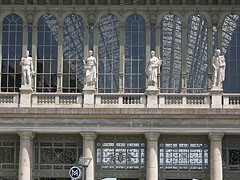 Four allegorical figures in the statue on the top of the Keleti Railway Station, above the main entrance
Four allegorical figures in the statue on the top of the Keleti Railway Station, above the main entrance
The four statues on the facade of the Keleti Railway Station over the main entrance were created by Gyula Bezerédi in 1884. But in the 1930s these were disappeared, seemingly mysteriously. For a while even the Russian (Soviet) army troops were suspicious that after the World War II they took the statues with themselves, but after analyzing some old photos it was revealed that the statues were disappeared from their place sometimes between 1935-1936. They were probably simply damaged and that's why removed from here. The statues were recreated in 2003 by Frigyes Janzer and Ferenc Gyurcsek.
These allegorical statues under the central clock refers to the close relationship between the railway and the other actors in the economy. Concretely: the miner represents the heavy industry, the spinning woman the light industry, the picker woman the agriculture, as well as the merchant symbolizes the trade and commerce.
 The allegorical statue on the top of the facade of the Keleti Railway Station
The allegorical statue on the top of the facade of the Keleti Railway Station
On the top of the front wall of the Keleti Railway Terminal at 43 meters high there is a sculpture group called "The allegory of the transportation". The composition represents the birth of the railway with a unique metaphor: between the gods of the fire and the water (in the ancient Roman mythology Vulcan and Nepune) a female figure symbolizes the birth of the steam.
The artwork needed to be completely recreated during the renovations of 1990, because the original tin plate statues were very ruined. Now the new statues were casted of aluminum alloy.
Considering the sculptor of the original statue from 1884 there is no clear consensus. Some sources say the maker was Gyula Bezerédi, others claim it was created by Ede Mayer and Béla Brestyánszky based on the idea and sketches of Leó Feszler (or Leo Fessler).
ブダペスト, ハンガリー - もっとフォトギャラリー:
また、に興味があるかもしれません(関連ページ):
旅行ガイドの目的地:
ブダペスト(8,468の写真 + 21のパノラマ画像)
Buda Hills (Budai-hegység)(8,632の写真 + 21のパノラマ画像)
Pest megye (county)(15,122の写真 + 50のパノラマ画像)
ブダペストとその周辺(15,989の写真 + 52のパノラマ画像)
ハンガリー(27,287の写真 + 163のパノラマ画像)
そしてさらに:
(ここで内側:Buda Hills)
Budakeszi(88の写真)
Pilisszentiván(76の写真)
ここにすべてのパノラマ写真:
ブダペスト(21の写真)
Pest megye (county)(50の写真)
ブダペストとその周辺(52の写真)
ハンガリー(163の写真)
ヨーロッパ(165の写真)
ここにすべての通常の写真:
ブダペスト(8,468の写真 / 122のギャラリー)
Buda Hills (Budai-hegység)(8,632の写真 / 124のギャラリー)
Pest megye (county)(15,122の写真 / 221のギャラリー)
ブダペストとその周辺(15,989の写真 / 234のギャラリー)
ハンガリー(27,287の写真 / 462のギャラリー)
ヨーロッパ(30,494の写真 / 523のギャラリー)
あなたの友人と共有して下さい!
等
私達について - 法的事項および & 免責事項 -
すべての権利を保有
- ©2010-2022
Neuronit Creative Studio - Mogyoród / ブダペスト / ハンガリー



